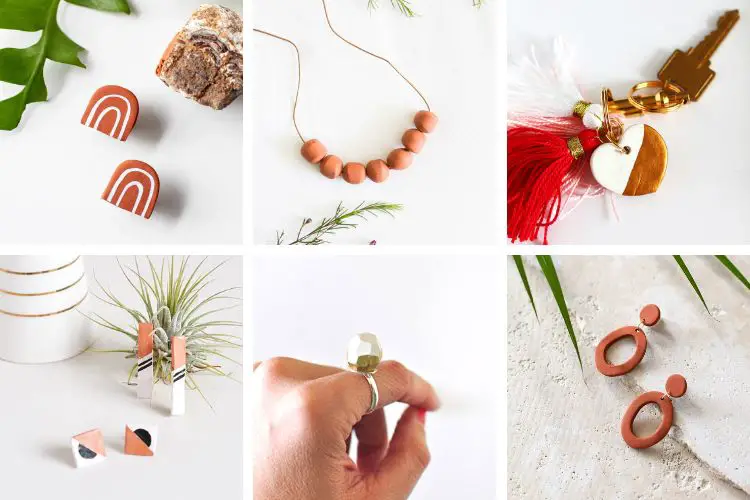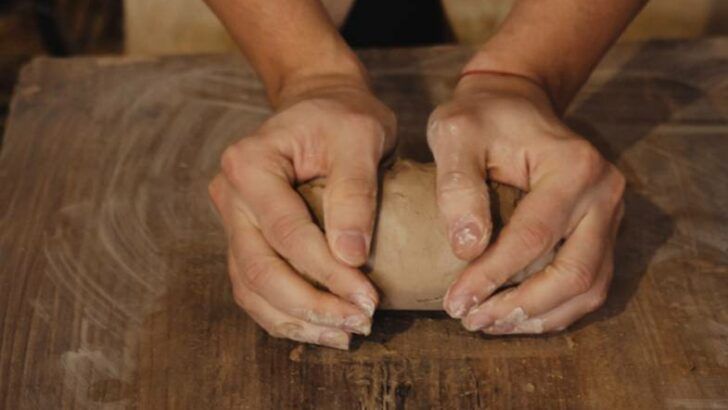How Much Clay Do You Need For A Small Pot?
Making small pots with clay can be a fun and creative way to start exploring ceramics and sculpture. For beginning potters or artists looking to try their hand at working with clay, starting with a small, simple pot is the perfect introduction to the craft.
When referring to a ‘small pot’ for clay projects, this typically indicates a piece that is hand-sized or smaller. Small clay pots tend to range from about 2-6 inches tall and 2-5 inches wide. Tiny pinch pots, small vases, bud vases, mini bowls, and diminutive plant pots all fall into this small pot category.
Determine the Size of Your Small Pot
When determining how much clay you need, the first step is to decide on the size of the small pot you want to make. Here are some typical dimensions for small ceramic pots:
- Tea light holders: 2-3 inches tall, 2-3 inches wide
- Small bud vases: 4-6 inches tall, 3-4 inches wide
- Succulent pots: 3-5 inches tall, 3-5 inches wide
- Mini bowls: 3-5 inches tall, 5-7 inches wide
To estimate the size, it can be helpful to draw a simple sketch or outline the shape you want on paper. You can also use everyday objects as size references – for example, a tea light holder may be around the size of a tennis ball.
Measuring precisely with a ruler and marking the dimensions on paper is the most accurate way to determine the size. Record the widest points and tallest height needed. This will give you the total volume to calculate how much clay is required.
Calculate the Amount of Clay
The basic formula for calculating how much clay you need for a small pot is:
(Pot Height x Pot Width x Pot Depth) x 0.4 = Clay Amount (ounces)
Let’s look at some examples with different pot sizes:
For a pot that is 4 inches high x 3 inches wide x 3 inches deep:
(4 x 3 x 3) x 0.4 = 14.4 ounces of clay needed
For a pot that is 6 inches high x 5 inches wide x 5 inches deep:
(6 x 5 x 5) x 0.4 = 60 ounces of clay needed
As you can see, the clay amount scales up quickly as your pot size increases. Even a small change in one dimension can significantly increase the total clay required.
Factors That Affect Clay Amount
When calculating how much clay you need for a small pottery project, there are several factors that can affect the total clay required.
Wall Thickness
The thickness of the pottery walls will significantly impact clay needs. Thicker walls require more clay, while thinner walls use less. For small pots, aim for walls approximately 1/4″ thick. Thicker walls up to 1/2″ can provide more durability for frequent use. Very thin walls under 1/8″ may be prone to cracking or warping.
Type of Clay
The type of modeling clay used can also affect the amount needed. Oil-based clays like plasticine use smaller amounts. Air-dry clays require more bulk, while polymer clays fall somewhere in between. Firmer clays like stoneware and porcelain tend to use less due to their density, while softer earthenware clays are lighter and require more volume.
Building Method
The technique used to construct the pot also impacts clay needs. Handbuilding methods like coils and slabs use more clay to account for overlap and attachments. Wheel throwing can conserve clay, but allows for thicker walls than handbuilding. The building method also affects the flexibility of clay walls, which can minimally alter clay needs.
Tips for Clay Conservation
When working with clay, it’s important to find ways to conserve the precious material. Here are some tips to help you use clay efficiently:
Reuse scrap clay – Any clay scraps or trimmings can be rehydrated and reused. Simply spray or soak dried clay pieces to make them malleable again. You can even reuse failed projects.
Throw thinner walls – Focus on throwing pots with thinner walls to conserve clay. Pay attention to wall thickness and aim for an even thickness throughout the piece. Thin walls require less clay.
Build pots taller rather than wide – Stretch clay vertically instead of making wide squat pots. The height will give the illusion of size without requiring more clay.
Optimize clay recycling – Set up an effective system to recycle all clay scraps. Keep a bag or bin nearby when working to collect trimmings. Rehydrate periodically.
Using these clay conservation tips will help your clay stash last longer. Reduce waste and reuse clay effectively with mindful studio habits.
Storing Leftover Clay
When working on small pottery projects, you’ll likely have leftover clay. Properly storing the unused clay allows you to use it for future projects. Here are some tips for keeping clay moist and usable for as long as possible:
Use airtight containers – Store clay in a plastic bag or airtight plastic container. Plastic wrap pressed onto the surface of the clay can also help prevent drying out. The goal is to keep air from reaching the clay.
Spritz with water – Lightly mist the clay with water before sealing in an airtight container. This provides extra moisture.
Avoid metal containers – Don’t use metal tins or bowls, as these can cause clay to dry out faster.
Store in cool location – Keep clay in the fridge but not the freezer. The cold helps retain moisture.
Knead before reusing – After storage, knead the clay fully with your hands until pliable before using for another project.
With proper airtight storage and occasional misting, clay can last for several months up to a year before drying out. By keeping leftover clay moist, you’ll always have material ready for your next small pottery project.
Buying Clay for Small Projects
When working on small pottery projects, you likely don’t need to buy clay in bulk. Many art supply stores sell clay in smaller quantities that are convenient for small projects.
Clay often comes in 25 lb or 50 lb blocks. This is enough clay for several small projects. You can also find 1 lb or 5 lb bags of clay, which are great for single small pots or sculptures.
When estimating how much clay to buy, consider how many projects you want to make and the size of each one. For example, if you want to make five 6-inch pots, you may need around 5-10 lbs of clay total. Buying a 10 lb bag would give you plenty of extra clay.
Clay costs around $15-25 for a 25 lb block and $5-10 per 1 lb bag. Buying in bulk is cheaper per pound. But for small projects, a 1 lb bag is very affordable. Just buy enough clay for your needs without overspending.
With some planning and buying clay in appropriate quantities, you can purchase exactly what you need for small pottery projects on a budget.
Alternatives to Clay
While clay is a popular choice for making pottery and sculptures, there are other materials you can use instead of clay for small arts and crafts projects:
Polymer Clay – Polymer clay is made from PVC and does not require firing in a kiln. It air dries into a hard plastic material. Polymer clay is very lightweight and easy to work with. It comes in many colors and can be blended together. However, polymer clay sculptures are not as durable as real fired clay.
Paper Mache – Paper mache involves building a sculpture or pot using newspaper, glue, and other materials. Paper mache is extremely lightweight and inexpensive. However, the finished product will not be as sturdy or long-lasting as real clay. Paper mache also takes longer to dry and mold.
Dough – Simple salt dough or play dough can be used to hand sculpt small items and ornaments. Dough is very easy to work with and dries hard. But dough pieces are fragile and less permanent than real clay.
The main advantages of clay are that it can be fired for permanence, it can hold very fine detail, and high quality clay works can last for centuries. The downsides are that clay requires more tools, equipment, and specialty knowledge. The alternatives listed above are good for small non-permanent projects, especially with children. But for more advanced pottery and sculpture, real clay remains ideal.
Troubleshooting Clay Amount
If you’ve started working on your small pot but realize you don’t have enough clay, there are a few signs to look out for and fixes to try:
Signs You Don’t Have Enough Clay
The pot feels flimsy or thin when working the clay. There are holes or gaps in the sides that are hard to fill in smoothly. The pot collapses or cracks easily when handling it before firing. You’ve used up all the clay and still need more to complete the project.
Fixes for Not Having Enough Clay
Buy more clay in a matching color. Blend new clay smoothly into the existing work. Reinforce thin areas by gently pressing extra clay to the interior and exterior. Allow extended drying time for added strength. Consider altering the design to use less clay if needed.
Avoiding Waste from Too Much Clay
Plan projects in stages using partial amounts of clay. Knead and wedge leftover clay thoroughly to remove air bubbles. Store tightly wrapped in plastic to prevent drying out. Recondition old clay by mixing in some water. Use excess clay to make decorative embellishments. Practice sculpting skills with spare clay.
Conclusion
Estimating how much clay you need for a small pottery project is an important first step. By calculating the clay amount based on your desired pot size and type, you can avoid wasting clay or running out before finishing your piece.
The key steps are determining the measurements and volume of your pot, calculating the clay needed based on those dimensions, and adding extra as needed for techniques like coiling. Applying a rough industry standard of 1-2 lbs per cubic foot of clay is a good starting point for small projects.
Knowing how much clay is required allows you to be efficient and get the most out of your clay supply. With some simple measurements and planning, you can have the right amount ready before throwing or handbuilding.
For more tips on clay conservation, storage, and working with small amounts, consult online pottery guides or connect with ceramicist communities. Mastering clay estimation will make all your future projects easier and more enjoyable.




